Loss of tradition: confiscation and the Native Land Courts devastating impact on Maori society after the wars.

image source
In 1800 the Maori owned over 60 million acres of land; by 1911, they owned only 7 million, much of which was not well suited for farming.1
There was a huge impact on Maori society after the wars in nineteenth century New Zealand, as the colonists moved to integrate the Maori people into their system of governance. A lifestyle they had been accustomed to before any settlers arrived was no longer a viable option, and the Maori found they had to adapt to a new way of life regardless of whether it suited them or not. There were those who found the new system agreeable, and they adapted easily, but for the majority it was no easy path. Resisting the changes brought trouble to them, and non-resistance meant no hope of stopping what was starting to look inevitable – the disappearance of their customary rights.
The creation and implementation of the Native Land court after the wars brought devastating results to the Maori people, and two parliamentary Acts played major roles in negatively impacting on all Maori: the New Zealand Settlements Act, 1863 and the Native Lands Act, 1865.

image source
The New Zealand Settlements Act, 1863 was a law designed to ease the way for more settlement of New Zealand, but underlying clauses allowed confiscation of North Island Maori lands as both a means to supposedly offset the costs of pursuing peace, and punishment for rebellious or insurrection-involving acts by tribe members ‘against Her Majesty’s authority’, although in reality much of the confiscated land was appropriated because areas had good productive settlement land, or was needed for building transportation routes.
As a result of these [the New Zealand] wars, around 1.5 million hectares of land were confiscated from tribes in Taranaki, Waikato, Tauranga and the Bay of Plenty. At the time it represented about 15% of land in Māori customary ownership. Much was returned, but not always to the original owners.2
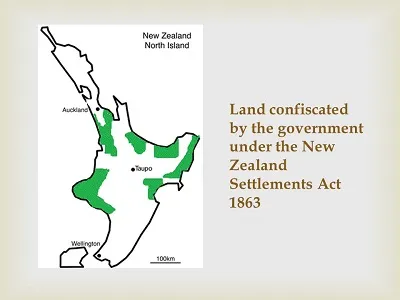
image source
Blocks which were taken but never used by the government nor sold to settlers remained unutilised, rather than being returned to the original Maori owners. This was frustrating, and some Maori refused to comply with the government, either by rejecting compensation payments, or, as Te Whiti o Rongamai did in 1880,
began to actively claim back confiscated land that had not been used by the government, proceeding on the basis that Māori only had to enter the land and plough it to re-establish their rights.3
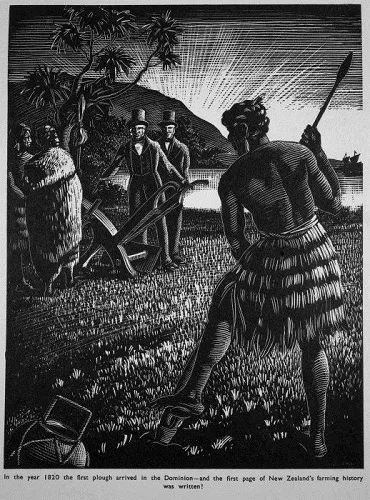
image source
Unfortunately for those who tried to take a stand, the government came up with harsher measures to try and end their defiance, calling in armed police to expel tribe members from the land, thus displacing them from their land- ties and their means of survival. If they didn’t have land then they didn’t have a place to grow crops and feed their people, and their chief didn’t have a base for his mana, so important to him by which to be a chief with power for the tribe. The Maori had their hands figuratively tied, because if they tried to protest their lack of equality as both British citizens and people of New Zealand then they could be conceived as being rebellious, but if they did nothing then the unbalanced status quo would never change. Between this Act and the Native Lands Act 1865, which was said to have been aimed in part to ‘detribalise native society’,4 the government made strong attempts to integrate the Maori into the colonists’ world.
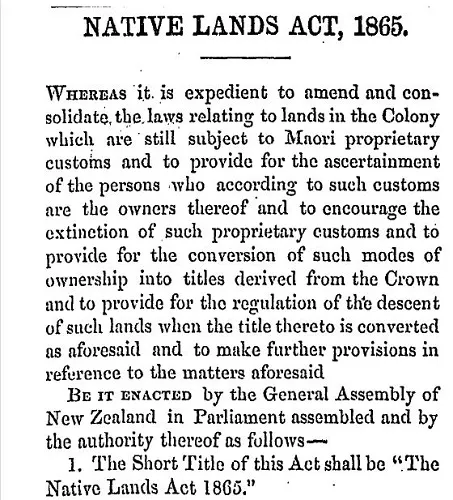
HAWKE'S BAY HERALD, VOLUME 8, ISSUE 699, 11 NOVEMBER 1865
image source
The initial idea behind a Native Land court and Native Land acts was the government’s reluctance to see another war, such as when a land dispute brought on the Waitara war. Maori were acknowledged as having legal rights to their land, and to be able to do with it whatever they wished, as recognised British subjects.
… the New Zealand Parliament eventually passed the Native Lands Act of 1865, which set up a new court, the Native Land Court, to assign land titles to individual Maori, and authorized Maori owners of such land to sell the land to private purchasers. The Native Lands Act proved extraordinarily successful in breaking down Maori resistance to land sales, and thus reducing the price of Maori land, because it transferred decisionmaking authority from tribes acting collectively to Maori wishing to sell.5

An 1843 watercolour by Samuel Brees shows buildings on the Wellington waterfront including, on the right, the courthouse.
image source
Settlers, of course, wanted quick resolutions to land disputes, they wanted more land to purchase, and they wanted to be able to deal directly with the Maori owner of the land, rather than have to buy government-owned blocks, as they knew they would be able to obtain it at a cheaper price, with the more unscrupulous amongst them going as far as defrauding the Maori out of their land without any reparation. Also, pressure on Maori to sell their land before another possible claimant did ensured that market forces dictated they would get a low price for the land. On top of that there were incurred costs associated with selling a block of land, and the Maori were bearing the brunt of these costs, like court fees, lawyers, interpreters and surveyors. They might also have to travel far to get to the court, and spend months away from home while the claim was being sorted out, so had the added burden of food and lodging costs. Their agricultural calendar was disrupted, often to the point where they could lose a badly-needed crop. In many cases they returned home poorer than they left, a high number having been trapped into debt by unscrupulous traders and profiteers, so even if they managed to sell their block of land, their debts offset any profit they may have seen. The Maori were ensnared in a system that was not working for them.
A single individual’s filing in the Native Land Court would necessarily draw the entire tribe into Court, because the Court would be determining the rights of everyone in the land, not just the initial applicant. If one stayed out of the proceeding, one risked losing one’s interest in the land.6
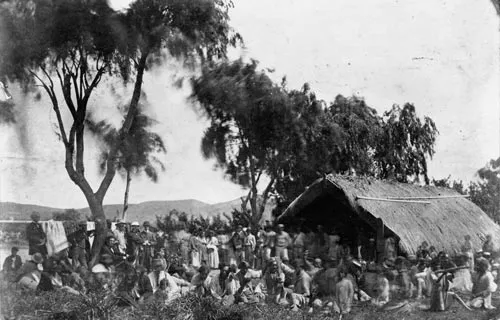
Donald McLean, seated by the tree on the left, negotiates the purchase of land at Wairoa from the local Ngāti Kahungunu people in 1865. McLean was the head of the Native Land Purchase Office, and became native minister in 1869. He convinced chiefs to sell land cheaply by telling them that positive economic effects would follow.
image source
Some colonists were concerned that the system was so flawed, but no-one could come up with a satisfactory alternative, so the system continued to disadvantage the Maori people.
Some Maori losses over the course of the 19th century were caused by outright fraud by the English. Some were caused by an inability to bargain as well as the English. Some sellers frittered away the proceeds. But much of what the Maori lost in the 19th century cannot be attributed to the actions of individuals, whether sharp practice by buyers or imprudence by sellers. Those losses were due instead to the structure of the market in which buyers and sellers operated … The market looked the way it did, of course, because the British were powerful enough to design it and to rebuff Maori efforts to impose a different structure.7
Loss of land and the amassing of debt to settlers – whether obtained by fair or unscrupulous means - ensured that the Maori lost both their traditional way of life and became the lowest socio-economic group in New Zealand. Most Maori were excluded from being eligible to vote, because of their communal system of land ownership, and therefore they did not have a strong voice in the parliamentary system of New Zealand government. They also had no bargaining power; if the government needed land, they created an Act in order to take it, and land was all that Maori had of importance. Active resistance brought the military against them, and while they had proven to be smart in warfare, they were ill-equipped in both man-power and funds so could not make any long protests. Internal leadership problems were also becoming an issue.
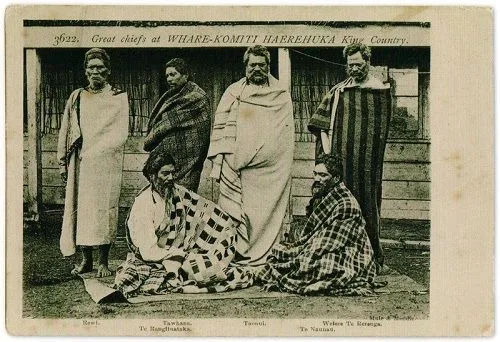
Burton was given permission to photograph six chiefs of Ngati Maniapoto, who were meeting at Whare Komiti Haerehuka in June, 1885.
image source
Great Maori leaders were disappearing, either through losses in the war, or through loss of mana and thus strong leadership ability. The colonists were happy to see this loss as it meant less resistance to integration into their ‘new’ New Zealand. With the rush to sell off blocks of land to either the government or settlers, chiefs found themselves with no control and no authority.
As tribal authority broke down, so did the tribe’s ability to enforce traditional property rights in land … issues of traditional property ownership were to be referred to the newly created Native Land
Court …8
This meant that the customary ways which Maori tribes used for dealing with conflict and disputes were invalid in the system the new government was installing in New Zealand.
The deterioration of tribal authority and the sale of land … each promoted the other. The more land was sold, the less the tribe could take on its traditional role of enforcing Maori property rights. The less the tribe could enforce property rights, the more commons-like and hence less valuable its remaining land became, and the more likely it was to be sold.9
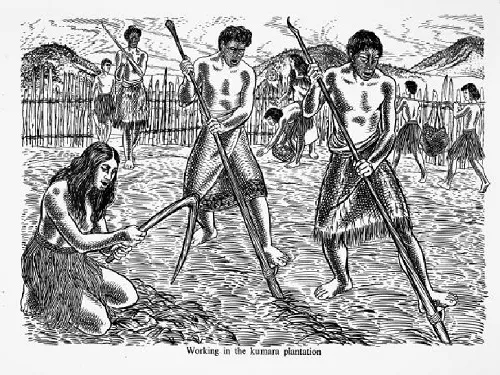
image source
As the government rules meant Maori ownership of land on an established title passed equally to all their descendants, the original parcel of land became more fragmented with every generation. What had started off as a piece of land large enough to sustain both a tribe and its future generations, through the system of farming and harvesting which had worked well for them before the colonisation of New Zealand, was no longer viable. They were not set up for the intensive farming system which the Europeans had become used to. Maori became forced to seek work away from their land, in order that they and their family not starve, but it was not just their physical well-being which suffered. They had strong spiritual ties to the land of their ancestors, having the emotional link while they were living on the land, but the further they had to move away in order to survive, the harder it was for them to maintain the connection and the more they grieved for the loss of their other, but no less important, unseen bonds. They were also becoming rudderless, as the loss of land brought on the disintegration of the chiefs’ leadership roles over their people. According to one observer in 1891, James Mackay,
“chiefs then had a power they have not now … The Native Land Court put in all the rag, tag, and bobtail, and Jack became as good as his master. That is one of the effects of the change.”10
There was no way of stopping the changes so devastating to the traditional Maori way of life.
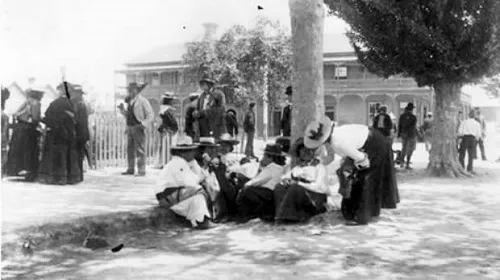
Māori men and women congregate outside the Rotorua courthouse on election day, possibly in 1908
image source
Confiscation of land by the government for so-called rebellious acts against the Crown, the Native Land court, and both the New Zealand Settlements Act, 1863 and the Native Lands Act, 1865 combined to bring devastation to the traditional Maori way of life. While the government and many settlers saw this as a positive thing, the majority of Maori could not, but they were powerless to either change or halt progress. In the end it left them worse off than before the colonists came. Their chiefs were mana-less, they lost most of their sustainable land, and they found themselves in the lowest socio-economic class in New Zealand, struggling to survive amongst the European-instilled lifestyle, and trying to cope in a very unbalanced society. The loss of their traditional society impacted them deeply, not only in physical ways, but at spiritual and emotional levels too, as their ties to the land were very important to them on many levels.
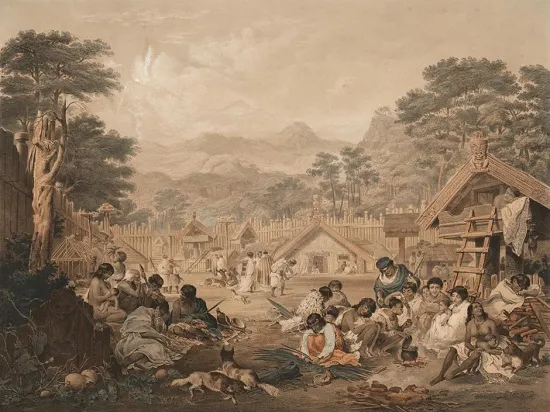
Pūtiki pā on the Whanganui River in 1850, based on a now-lost oil painting by John Alexander Gilfillan.
image source
This essay was one I wrote as an assignment, while obtaining my University degree. I have included the reference list and bibliography - reference materials I used while writing - just as I’d had to for its submission. It has never before been published anywhere public, though. Images have been added for visual interest.
Endnotes:
1 Banner, Stuart. “Two Properties, One Land: Law and Space in Nineteenth-Century New Zealand.” Law & Social Inquiry 24:4 (1999) p. 844. 6 September 2010 < http://www.jstor.org/stable/829147>
2 Te Māori I te ohanga – Māori in the economy: the alienation of Māori land. 7 September 2010 < http://www.teara.govt.nz/en/te-maori-i-te-ohanga-maori-in-the-economy/4>
3 New Zealand Land Confiscations 7 September 2010
http://wapedia.mobi/en/New_Zealand_land_confiscations?t=3.
4 The Native Lands Acts and the Native Land Court. 4.2. p. 59. 7 September 2010 http://www.waitangi-tribunal.govt.nz/doclibrary/public/researchwhanui/theme/c/Chapt04.pdf
5 Banner, Stuart. “Conquest by Contract: Wealth Transfer and Land Market Structure in Colonial New Zealand.” Law & Society Review 34:1 (2000) p. 66. 6 September 2010 http://www.jstor.org/stable/3115116
6 ibid.. p. 67.
7 ibid., p. 90.
8 Banner, Stuart. “Two Properties, One Land: Law and Space in Nineteenth-Century New Zealand.” Law & Social Inquiry 24:4 (1999) p. 845. 6 September 2010 < http://www.jstor.org/stable/829147>
9 ibid., p. 847.
10 ibid., p. 844-5.
References:
Banner, Stuart. “Conquest by Contract: Wealth Transfer and Land Market Structure in Colonial New Zealand.” Law & Society Review 34:1 (2000) pp. 47-96. 6 September 2010 http://www.jstor.org/stable/3115116
Banner, Stuart. “Two Properties, One Land: Law and Space in Nineteenth-Century New Zealand.” Law & Social Inquiry 24:4 (1999) pp. 807-852. 6 September 2010 < http://www.jstor.org/stable/829147>
Belich, James. The New Zealand Wars. Auckland: Penguin Books, 1998.
Bohan, Edmund. To Be A Hero: a biography of Sir George Grey. Auckland: HarperCollins, 1998.
Dalton, B. J. War and Politics in New Zealand: 1855-1870. Sydney: Sydney UP, 1967.
New Zealand Land Confiscations 7 September 2010
< http://wapedia.mobi/en/New_Zealand_land_confiscations>
http://wapedia.mobi/en/New_Zealand_land_confiscations?t=3.
Rutherford, J. Sir George Grey K.C.B., 1812-1898: A Study in Colonial Government. London: Cassell & Company, 1961.
Te Māori I te ohanga – Māori in the economy: the alienation of Māori land. 7 September 2010 < http://www.teara.govt.nz/en/te-maori-i-te-ohanga-maori-in-the-economy/4>
The Native Lands Acts and the Native Land Court. 7 September 2010 http://www.waitangi-tribunal.govt.nz/doclibrary/public/researchwhanui/theme/c/Chapt04.pdf
The New Zealand Settlements Act of 1863 7 September 2010
http://www.teara.govt.nz/en/te-ati-awa-of-taranaki/3/2



(extra tags: #geopolis #maori #newzealand #culture #minnowsupport)
